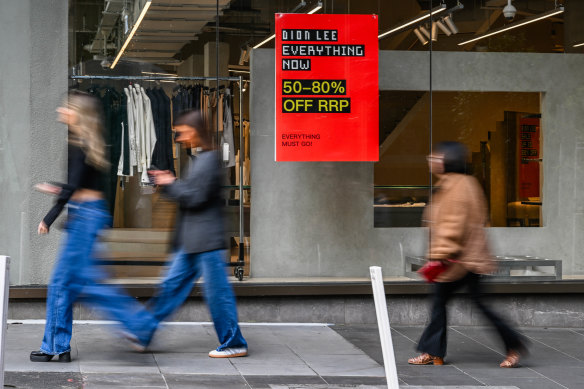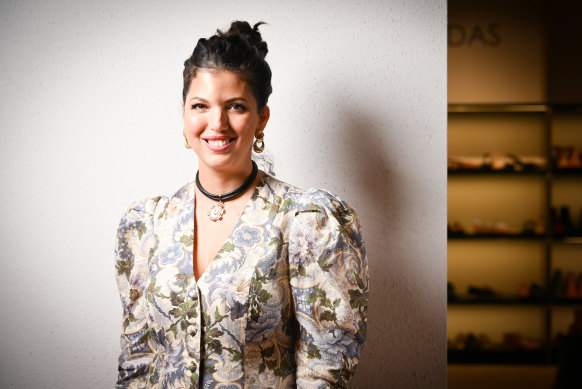This was published 6 months ago
Opinion
Australians buy more new clothing than anyone else. So why is our fashion industry dying?
Melissa Singer
Associate Editor, Sunday LifeWhat sector employs more people than mining and the arts, and exports more in dollar terms than the wine industry, but is routinely dismissed as frivolous and superficial? Fashion, of course.
But despite what local fashion brings to the economy, a new report from the Australian Fashion Council published on Tuesday shows the industry is on life support and warns that without government investment – particularly in Victoria, where one-third of the sector is based – things will go from bad to worse.

Australian fashion label Dion Lee will be wound up after failing to find a buyer.Credit: Joe Armao
Victoria’s clothing manufacturing sector, which powers fashion brands across the country, has shed $200 million – or 18 per cent – of its value since 2019. With additional support, including the rollout of “smart factories” that use technology like digital sampling to minimise waste, the sector can add $225 million to the state’s economy and create 1500 jobs. Without further investment, the council warns, it will lose another $98 million and 700 jobs by 2030.
Add to that the number of Australian fashion labels that have shut down in the past year, plus the many now struggling to make ends meet, and it paints a bleak picture of an industry that brings so much to our economy.
Last week’s announcement that Dion Lee would be wound up after failing to find a buyer not only marked the downfall of what was once one of the country’s hottest labels, it also sent ripples through the industry. As one designer privately put it: “If Dion Lee can’t survive, what hope do we have?”
If Australians wake up to the reality that local brands desperately need our support, there is hope. And while the Australian Fashion Council does the important work of shoring up support for local manufacturing, it’s just one piece of the puzzle. To use an Olympic metaphor, Australian-made gets the gold medal, but shopping Australian-owned – where fashion is designed locally but produced offshore – is a photo-finish for silver.
At the start of the pandemic, “buy Australian” rhetoric enjoyed a mini-renaissance, as patriotic consumers with newfound spare time and disposable income flocked to local brands. A campaign called We Wear Australian, launched by West Australian fashion identities Richard Poulson and Kelly Atkinson, received widespread coverage – including in this masthead. But years later, where is that consumer support?
I’ll tell you where it is. It’s in Kmart, which last week reported a massive jump in revenue, largely due to the success of its in-house brand, under which most of its clothing is sold. It’s also in the coffers of fast-fashion giants such as H&M and the ultra-fast sector, led by China-based Shein, where a T-shirt can cost as little as $1.59.
Australians are living through some of the most challenging economic pressures in decades. It’s understandable that for many, buying clothing has gone from a seasonal pastime to a luxury, with consumers “downshifting” to more affordable brands.
But, as a recent study from the Australia Institute showed, despite the cost-of-living pressures, fashion consumption is at an all-time high. The average Australian now buys 56 items of new clothing a year, more than any other country in the world based on population. And, as the average value of each new garment – $13 – suggests, a large slice of that is from fast-fashion companies with questionable records on everything from the use of toxic chemicals to workers’ rights.
Not everyone has the means to buy from high-end local brands, but the idea that local costs more isn’t true. There is a wide array of Australian-owned brands at more accessible prices. And no one is asking you to buy the whole store – just a T-shirt or a pair of earrings helps. Sure, buying Australian-made gives us the warm fuzzies, but buying Australian-owned – even if it’s made in China or Turkey – still helps keep our industry vibrant.

Lesleigh Jermanus, founder of Alemais, says most of her brand’s sales come from overseas.Credit: Eddie Jim
The reality is that Australian consumers, even (and especially) the well-heeled ones, can do more to support local brands. One of the country’s biggest post-COVID success stories, Lesleigh Jermanus of Alemais, recently told The Australian Financial Review that 80 per cent of her sales now come from overseas. Another designer told me recently that if not for her international accounts and clients, she would not have a business after nine of her Australian stockists closed down.
As the Australian Fashion Council secures more funding and government support for fashion manufacturing, there is something just as important that we can do: shop Australian. If it seems like this call to action is a familiar refrain, it’s because it’s evergreen. And yet, for an industry that brings so much to the economy, we keep failing to give Australian fashion the love it deserves. So, for the hundredth time: buy less and buy local. Now, someone pour me a wine.
Make the most of your health, relationships, fitness and nutrition with our Live Well newsletter. Get it in your inbox every Monday.